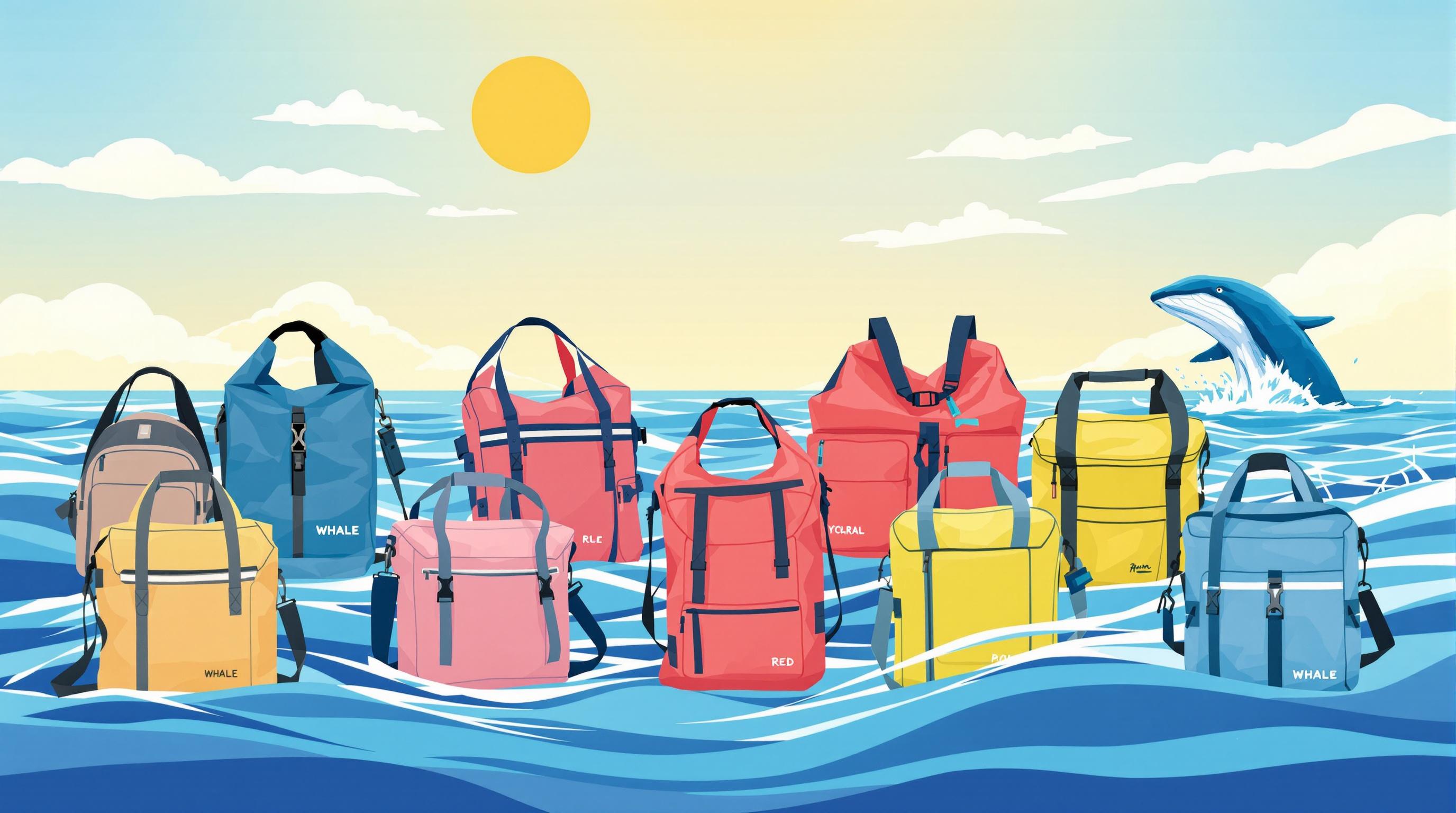Looking to enhance your whale watching tours with underwater sound? Here's what you need to know about choosing the right hydrophone:
- Hydrophones are underwater microphones that capture marine life sounds
- Key features: sound range, quality, and durability
- Two main types: resonant and flat response
- Consider group size, ocean conditions, and budget when selecting
Quick comparison of popular hydrophones:
| Model | Best For | Price Range |
|---|---|---|
| SQ26-H1 | Small groups, beginners | $100-$200 |
| CR1-UDP | Medium tours, durability | $500-$1000 |
| C57-PAS | Large groups, professional use | $1000+ |
5 steps to choose a hydrophone:
- Check technical needs (frequency, sensitivity)
- Consider extra equipment (cables, preamps)
- Set a budget
- Assess durability requirements
- Decide between single or array setup
Remember: The right hydrophone can turn a good whale watching tour into an unforgettable experience.
Related video from YouTube
Key Hydrophone Features
Picking the right hydrophone for whale watching? Focus on these three things: sound range, quality, and toughness.
Sound Range
Whales make all sorts of noises. Your hydrophone needs to catch them all.
Take the Cetacean Research™ CR1A:
- It picks up sounds from 0.00016 to 48 kHz (and up to 68 kHz if you push it)
- That's enough for blue whale rumbles AND dolphin whistles
Sound Quality
Clear sound matters. The CR1-UDP system is a top pick for whale watching tours.
What makes good sound?
- High sensitivity: Catches quiet noises
- Low self-noise: Less background fuzz
The CR1A's self-noise is just 38 dB at 1kHz. That's quieter than a calm sea!
Toughness
The ocean's rough. Your hydrophone should be too.
Look for:
- How deep it can go
- Temperature range
- Durability
National Geographic uses C57 series hydrophones. They're built tough and work well when towed behind boats.
| Feature | CR1A | C55RS2 |
|---|---|---|
| Max Depth | 500 m | 460 m |
| Temp Range | -25 to 60°C | -40 to 60°C |
| Material | Tough coaxial cable | Rugged polyurethane |
Pick a hydrophone that fits your needs, and you'll be set for some amazing whale watching!
Hydrophone Types for Whale Watching
Choosing a hydrophone for whale watching? You've got two main types to pick from: resonant and flat response. Plus, you'll need to decide if you want a built-in amplifier or not. Let's break it down.
Resonant vs. Flat Response
| Type | Pros | Cons | Best For |
|---|---|---|---|
| Resonant | Boosts specific frequencies, cheaper, good for DIY | Less accurate, might miss some whale sounds | Specific whale species, budget tours |
| Flat Response | Captures wide range, more accurate, picks up diverse marine life | Pricier, may need extra gear | Pro tours, research, varied marine sounds |
Take the Oceanphonics hydrophone. It uses an air cavity to boost mammal sounds - great for tours focusing on specific whales.
On the flip side, the Cetacean Research™ CR1 series gives you a flat response. It picks up sounds from 0.00016 kHz to 48 kHz (up to 68 kHz). Perfect for catching all sorts of whale chatter.
Built-in Amplifier vs. No Amplifier
| Feature | With Amplifier | Without Amplifier |
|---|---|---|
| Ease of Use | Plug-and-play | Needs external amp |
| Sound Boost | Built-in | Depends on external gear |
| Flexibility | Limited to built-in amp | Can use different amps |
| Cost | Often pricier upfront | Might be cheaper, but amp costs extra |
| Best For | Quick setups, smaller boats | Custom setups, bigger operations |
The HY-10 system comes with a built-in amp. It's ready to go right out of the box.
The DolphinEar PRO, however, doesn't need phantom power. This makes it a solid choice if you want to use your own amp setup.
So, what's your whale watching style? Focusing on specific whales or want to hear it all? Need a simple setup or prefer more control? Your answers will point you to the right hydrophone for your adventures.
What You Need from a Hydrophone
Picking the right hydrophone for whale watching tours? It's not about the fanciest gear. It's about finding what works for you. Let's look at what matters.
Group Size and Needs
Your group size and their expectations? They're key.
| Group Size | Hydrophone | Features |
|---|---|---|
| Small (1-10) | SQ26-H1 | Compact, cheap, good for newbies |
| Medium (11-30) | CR1-UDP | Tough, clear sound, works with boat systems |
| Large (30+) | C57-PAS | Top-notch, used by National Geographic |
Got a small group? Just starting out? The SQ26-H1 from Cetacean Research Technology is your friend. It's small and won't break the bank.
Running medium tours? Check out the CR1-UDP. It's built to last and sounds great. Bonus: it plays nice with your boat's sound system.
Want to go big? The C57-PAS is the way. It's what National Geographic uses. Enough said.
Ocean Conditions and Cost
Where you sail and what you can spend? They matter too.
| Ocean | Hydrophone Needs | Cost |
|---|---|---|
| Calm | Standard models work | Cheaper upfront |
| Rough | Need tough models | Pricier, but lasts longer |
| Deep | Special deep-water gear | More expensive, but necessary |
Calm waters? You can get by with less. Rough seas? Spend more now on something like the CR1-UDP. You'll thank yourself later.
Think beyond the price tag:
- Tough gear lasts longer in harsh conditions.
- Better systems can mean better tours and happier customers.
- Don't forget about upkeep costs.
"A single hydrophone is like one mic in the air. You hear sounds, but can't tell where they're coming from." - James Crutchfield, UC Davis Physics Professor
This shows why fancier systems matter. One hydrophone works, but multi-directional setups? They give you the full picture of whale chatter.
sbb-itb-735af6e
5 Steps to Choose a Hydrophone
Picking a hydrophone for whale watching? Here's how:
1. Check Technical Needs
Know your sound range, quality, and noise reduction needs.
| Feature | What to Look For |
|---|---|
| Frequency Response | Match whale sounds (10 Hz to 40 kHz) |
| Sensitivity | Higher is better (-167 dB > -192 dB) |
| Noise Floor | Lower is better (42 dB > 55 dB) |
The Cetacean Research Technology C57 has -167 dB sensitivity. Good for whale watching.
2. Extra Equipment
You'll need:
- Cables (length depends on boat)
- Attachment method
- Preamplifiers
C57 comes with a 15m cable ($545). Works for smaller boats.
3. Budget
Prices vary:
| Model | Price (USD) |
|---|---|
| JrF D-series | ~$80 |
| Aquarian Audio H1a | $170 |
| Ambient ASF-2 | $500 |
| Cetacean Research Technology C57 | $999 (base) |
| Ambient ASF-1 | $1600 |
Aquarian Audio H1a ($170): good for small tours. Ambient ASF-1 ($1600): for serious research.
4. Durability
Rough seas? Get a tough hydrophone. Aquarian Audio H1a is rugged and compact.
5. Single or Array
Basic whale watching? Single hydrophone works. Want to pinpoint whales? Consider an array.
"A single hydrophone is like one mic in the air. You hear sounds, but can't tell where they're coming from." - James Crutchfield, UC Davis Physics Professor
Setting Up and Taking Care of Hydrophones
How to Install
Here's how to set up your hydrophone for clear whale sounds:
- Find a quiet spot on your boat away from engines
- Mount it securely (the CR1 hydrophone is tough for commercial use)
- Handle cables carefully to avoid noise (SQ26-H1 is compact and easy to manage)
- Always test before sailing
"Try unconventional things; you're recording in an unconventional environment!" - Colin Hart, Recordist
Upkeep and Fixing Problems
Keep your hydrophone in shape:
| Task | When | Why |
|---|---|---|
| Clean (fresh water) | After saltwater use | Stops corrosion |
| Check for damage | Before each trip | Catches issues early |
| Test audio | Weekly | Ensures clear sound |
No sound but green light? Check if:
- Whales are too far or quiet
- There are visual cues like ships
- Cables and connections are okay
For top-notch quality, consider the C57-PAS system used by National Geographic Explorer.
Making Whale Watching Better
Fun Activities with Whale Sounds
Hydrophones can turn a whale watching tour into something special. Here's how to use whale sounds to get your guests excited:
1. Sound Matching Game
Have guests match whale sounds to species. It's like Izzy P.'s science fair project where people matched sounds from Orcas, Right, Blue, Humpback, and Sperm Whales.
2. Whale Song Karaoke
Play humpback whale songs and let guests try to copy them. It's a fun way to show how complex whale sounds are.
3. Underwater Sound Speed Demo
Show how sound moves faster in water than air. It explains why whales can "talk" over long distances.
| Medium | Speed of Sound |
|---|---|
| Water | 1,500 m/s |
| Air | 332 m/s |
4. Whale Call Bingo
Make bingo cards with different whale sounds. As the hydrophones pick up sounds during the tour, guests mark their cards.
Teaching About Whales
Hydrophones are great for teaching about marine life. Here's how to use them:
1. Whale Communication 101
Use recordings to show how whales use different sounds:
- Whistles and pulsed calls for socializing
- Blue whales' low sounds (up to 188 decibels)
- Humpback whale songs for finding mates
2. Talk About Conservation
Explain how human-made noise affects whales. Talk about "masking" and how it messes with whale communication, navigation, and feeding.
3. Show Whale Variety
Play sounds from different whale species. It shows the diversity of marine life in the area.
4. Mix Sound and Sight
Pair hydrophone audio with visual aids like whale ID charts or behavior diagrams. It helps people learn and remember better.
Wrap-up
Picking the right hydrophone can make or break your whale watching tours. Here's what to remember:
- Sound Quality: Go for a hydrophone that captures whale sounds clearly. The C57-PAS system is a top performer.
- Toughness: Need something for rough seas? Try the CR1-UDP system.
- Cost: Just starting? The SQ26-H1 system won't break the bank.
- Special Features: Some hydrophones, like the Oceanphonics model, have tricks up their sleeve. It's extra sensitive to underwater mammal sounds.
- Learning Tool: Hydrophones do more than let you listen. They're great for teaching too.
"Opening up the oceans so people can hear whales in their environment has such power." - Jackie Hildering, Whale Researcher

